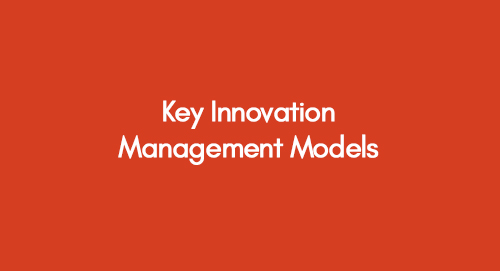
Data Analysis Using SPSS
June 2, 2022
Strategic Analysis of LEGO
June 2, 2022Innovation lies at the heart of progress and growth in today's dynamic business landscape. As organizations strive to stay competitive and relevant, the effective management of innovation becomes increasingly critical. Innovation isn't merely about generating new ideas; it encompasses a systematic approach to transforming those ideas into tangible outcomes that drive value. To harness the potential of innovation, businesses employ various management models that provide frameworks and methodologies for fostering creativity, driving change, and achieving strategic objectives. These models serve as guiding principles, helping organizations navigate the complexities of the innovation process while mitigating risks and maximizing opportunities for success.
In this blog, we explore some of the key innovation management models that have shaped the way organizations approach innovation and drive sustainable growth. From Design Thinking and Lean Startup to Agile Innovation and Open Innovation, each model offers unique perspectives and tools for managing the innovation lifecycle. By understanding and leveraging these models, businesses can foster a culture of innovation, streamline processes, and create a conducive environment for experimentation and learning. Ultimately, embracing innovation management models enables organizations to adapt to changing market dynamics, respond to customer needs, and stay ahead of the competition in an ever-evolving business landscape.
Exploring the realm of innovation management models reveals a diverse landscape of methodologies and frameworks pivotal in shaping organizational strategies for sustainable growth and competitive advantage.
Introduction
This literature aims to shed light on several key innovation management models commonly practised by businesses. Innovation, as defined by Loukis, Charalabidis, and Androutsopoulou (2017), encompasses novel ideas, imaginative concepts, or creative insights applicable to organizational systems through specific methods or techniques. In contrast, innovation management refers to the business discipline ensuring the consistent and sustainable implementation of innovation processes within an organization. One such model is Open Innovation, pioneered by Martín-de Castro (2015), which advocates for the utilization of both internal and external ideas to drive advancements in marketing and business. Open Innovation proposes leveraging knowledge from diverse sources to foster innovation and provide value to customers, a concept not limited to private enterprises but adaptable to non-profit organizations and academic institutions as well. Within the business innovation model, organizations are tasked with reevaluating their current business strategies to cultivate new revenue streams, necessitating enhancements to existing business models to bolster overall business value.
Innovation Models
Martín-de Castro (2015) further stated that two innovation management models are used for this report. The first theory used for this report is the Open Innovation theory. Open Innovation is defined as purposeful outflows and inflows of knowledge to accelerate internal innovation while expanding markets for the use of innovation externally.
Understanding the foundational principles and transformative potential of the Open Innovation Model Processes sets the stage for exploring its dynamics and applications in modern business environments.
Open Innovation Model Processes
Open innovation defines the process through which organizations utilize and access external innovation. Open Innovation model processes can combine external and internal ideas into systems and architectures. According to Martín-de Castro (2015), open innovation model processes employ business models for defining the requirements for systems and architectures.
Principles of Open Innovation Model
To implement this innovation management model during innovation, organizations should focus on the following principles of the open innovation model:
- The organizations must find and gain the knowledge and expertise of individuals outside the organization.
- The organization must know that external research and development may create value in the market, whereas internal research and development are required to claim a portion of that value (Open Innovation, 2020).
- Organizations should focus on building better business models rather than on market needs first (Open Innovation, 2020).
- Organizations must use internal and external ideas to progress in the market.
- The organization should profit from others using their IP and buy other organizations’ IP when it makes advancements in the organisation's business model.
Benefits of Open Innovation Theory
Martín-de Castro (2015) mentioned in the study that there are several benefits for organizations that adopt the Open innovation model for their businesses:
Quality of Services and Products
Open innovation can help organizations increase the level of their performance. In this way, TerraCycle can generate revenues and work on the different innovation processes. Schuurman (2015) argued that integrating the feedback from the partner firms during the innovative process can enable TerraCycle to target their development efforts to improve the quality of their services and products (Brant and Lohse, 2014).
Fewer Costs and Risks
Obtaining the technology and skills from external sources is beneficial for organizations. To gain these benefits, TerraCycle needs to create inputs and reduce the risks and costs linked with developing a product (Brant and Lohse, 2014).
Flexibility
As the market conditions are changing rapidly, Open Innovation will benefit TerraCycle as it permits the organization to become flexible and adapt the knowledge based on shifting commercial needs (Brant and Lohse, 2014).
Monetization
This innovation management model will enable TerraCycle to spread its business model and advance its technology (Brant and Lohse, 2014). TerraCycle can monetize its development investments through Open innovation. Through Open Innovation, TerraCycle organization can employ its ideas in the market. Open innovation will allow TerraCycle to profit from its partners' assets, including investor relationships and reputations (Brant and Lohse, 2014). New opportunities open when trust is developed between partners, which may further deepen the collaboration and sharing between TerraCycle and other organizations.
Moreover, Schuurman (2015) added that open innovation produces benefits that are helpful for innovation and technological advancement. Furthermore, Open innovation divides labour and specialization in development. This way, opportunities are provided for the TerraCycle organization to commercialize new solutions.
Limitations of the Open Innovation Model
According to Schuurman (2015), the open innovation model will impose a few limitations on TerraCycle, as the model advocates the use of organizational forms that have further restrictions in complex (problem-solving) environments such as innovation. To implement an open innovation model, TerraCycle should know that as the problems become more complex, the limitations of hierarchy (authority-based) are reached quickly, and another hierarchy (consensus-based) is introduced.
The second theory TerraCycle will be using is the Business model innovation. It defines innovation processes based on how the organizations deliver and create value, opposing the concept of creating new services and products (Santoro et al., 2018). Business model innovation helps to develop the idea that supports an organization's financial viability, including the processes and mission to make the concept fruitful for the organization.
Before exploring the Business Model Innovation Processes, it's essential to grasp the foundational concepts driving organizational adaptation and growth in dynamic market environments.
Business Model Innovation Processes
The business model innovation processes have been intact with sound business principles. These business principles have been outlined with the help of core business principles:
- Value proposition: the creation of unique and new value for customers
- Resources: Resources required for delivering the customer value proposition must be kept secure
- Processes: The organization must identify the fundamental business processes for delivering the customer value proposition
- Profit model: The organizations must design a profit model to gain profit
The organization must focus on these four features to make innovation in its business model.
Principles of Business Model Innovation
Rethinking the current business strategies and modifying them is another part of the innovation management model. For applying the business model innovation, organizations should consider the following processes:
Analyzing the Current Business Model
The organization must identify the market and its offerings, how the organisation's value proposition was created, and how the revenue was generated (Kylliäinen, 2020). The organization can design a business model canvas for this process.
Confront the Business Model
Innovation is essential for the advancement of business. For this purpose, the organization must create ideas that propose a challenge in the market and ensure what the current market demands. Out-of-the-box ideas are required to innovate the business of the organization. When the organization struggles with advancement in its business, it must confront its business model for innovation (Kylliäinen, 2020).
Consistency of Business Model
The organizations must ensure that the business model is kept consistent with the organisation's long-term vision.
Plotting and Testing
The organization must make iterations in the business model based on the findings. The organization must test the business model and its success and failure factors.
Benefits of Business Model Innovation
Business model innovation allows organizations to adapt to market changes, gain competitiveness, and foster sustainable growth by exploring new revenue streams and optimizing resource allocation.
Financial Sustainability
The most significant advantage of innovation in the business model is that it will contribute to making TerraCycle sustainable and can cope with the shifts in market conditions. Most organisations close their business doors because they cannot manage their financial situation. Therefore, a business model innovation will be beneficial for TerraCycle to make a profit each month.
Investment
The investors are well informed of the fact of business failures. Investors want to have explicit knowledge of TerraCycle's plans for profitability. A proper business model and profit statement will greatly benefit TerraCycle over the competitors in the market, and the investors will provide profitable investment (Ingram, 2020).
Plans for Advancement
An innovative business model will provide benefits and profit to TerraCycle consistently. A solid business model will help build cash reserves in TerraCycle to invest in equipment, development efforts, and property (Ingram, 2020). Moreover, business model innovations yield higher revenues than process and product innovations. According to Geissdoerfer, Vladimirova, and Evans (2018), sustainable business models provide the benefit of mitigating higher risk and resilience. The innovation management model for modifying business models is essential as it focuses on stakeholder value and benefits rather than customer benefit (Geissdoerfer, Vladimirova, and Evans, 2018).
Limitations of Business Model Innovation
TerraCycle should know that in business model innovation, the business model canvas has limitations that make the canvas less dynamic. The business model canvas has multiple theoretical views that are not linked. The business model canvas does not consist of theoretical features of dynamic capabilities that declare their static foundations (Rodrigues and Lopes, 2018). The business model canvas monitors and evaluates its results, and it consists of a rudimentary indicator for measuring the value that revenue generated minus cost structure (Rodrigues and Lopes, 2018). Moreover, the business model canvas does not comprise two main elements of a business model the customer need and the product or service. The business model canvas does not represent two-sided markets and networks.
In contextualizing the historical development, understanding the application of the Open Innovation Theory unveils insights into its transformative impact on industries and economies alike.
Application of the Open Innovation Theory in the Historical Development Context
The application of Open Innovation Theory in historical development reflects a paradigm shift in business innovation, leveraging external collaborations and diverse knowledge sources to drive progress and economic growth, fostering breakthroughs across industries.
Company Background
Leading consumer product companies, cities, facilities, and retailers are partnered with TerraCycle to reprocess packages and products, from cigarette butts to dirty diapers that would end up burnt or landfilled otherwise. TerraCycle is working with top product companies to integrate products that are difficult to recycle, such as ocean plastic. It is one of the fastest-developing companies and is the world’s leading company in using and collecting non-recyclable waste (Li, 2015). With the help of innovation management models, TerraCycle has implemented a business model canvas to advance its business in the market, as shown in the table.






TerraCycle started with eco-friendly fertilizer, which is produced from waste and worms. It is directed towards eliminating waste and saving resources, impacting worldwide environmental concerns. In twelve years, it aimed at making waste into new use again. Reusing cigarette butts and many other recycles is incredibly far beyond one imagination. These are further recycled into plastic pellets to produce industrial goods. Due to low subsidies and donations from the government, TerraCycle has started social entrepreneurship to instrument the social mission of telling the world about the value of environmental protection. Collectors are paid in cash, and the financing problem is solved. In the meantime, the company’s value and social impact are improved through its products in the market (Li, 2014). Over twelve years, TerraCycle has developed over 200 products, and these products are licensed to the manufacturers.
TerraCycle is involved in the manufacture of fertilizers that Vermicompost makes. Vermicompost is formed when organic waste is fed to worms. The worms are liquefied into compost tea, and this is done by mixing the compost tea with warm water and air in vats. In 2007, TerraCycle expanded its production into upcycling and started to develop its products from waste materials. TerraCycle was unable to upcycle the plastic packaging waste. These wastes were then recycled into raw materials used in plastic products. TerraCycle is a recycling company that introduced different recycling programs that enabled individuals to collect waste items. In 2019, TerraCycle revealed a loop that provides a packaging platform for companies having consumer packaged goods. This system offers shipping facilities through UPS and ships personal care products, food materials, and cleaning products in reusable containers. These products are distributed from these reusable containers.
Preceding the discussion on the Open Innovation Model and Business Model Innovation lies an exploration of their pivotal roles in reshaping contemporary business strategies and fostering sustainable growth.
Open Innovation Model and Business Model Innovation
The application of the open innovation model in TerraCycle depends on external sources, as it is the principle of the open innovation model to gain knowledge and expertise from external sources/individuals. This is critical to the process of innovation in any organization. The open innovation model will aim to improve the abilities of TerraCycle to provide new ideas for solutions and products through external ideas given by partners and consumers to accomplish success in the market. TerraCycle applies the open innovation model to build external strength through recycling or upcycling programs. The company aims to collaborate with leading consumer product companies and retailers to find various solutions. These programs will provide product support for entrepreneurs, which will help the entrepreneurs to build new services and products. According to Mortara et al. (2009), TerraCycle will have to focus on building independent open innovation teams that will work within the company. This will be the best choice to implement open innovation.
Moreover, TerraCycle will need the skills to implement open innovation because a lack of appropriate skills will be an obstacle to the implementation of open innovation (Mortara et al., 2009). TerraCycle may adopt this model on stages between entrepreneurs and teams or maybe on stages between the company and consumers. The open innovation model will involve the consumers in the production process, and TerraCycle will use the suggestions given by external ideas/partners, and these ideas can be processed to develop new products. According to Lee, Park, Yoon, and Park (2010), it is suggested that more focus should be given to the latter part of the traditional open innovation model so that the model is applied within TerraCycle. The open innovation model is used for companies that are working with other firms that specialise in marketing, which had an active collaboration and contribution in the innovation process, as is the case with TerraCycle, which is partnered with leading consumer product companies and retailers.
According to Cosyns and Cornfield (2018), waste has no value, and if left untreated, it offers negative value to society and the environment. TerraCycle will be applying the business model innovation for waste upcycling and recycling. There are three mechanisms for achieving sustainable business model innovation to create value from waste that involves the reduction of waste, for example, reverting the waste to the production stream for recycling and creating value from waste in the form of upcycling (Cosyns and Cornfield, 2018). The waste reduction will improve based on the current business model, but TerraCycle must apply business model innovation to create value from the waste.
Application of the Given Theories in Future Development Context
TerraCycle offers recycling programs which various brand retailers and manufacturers fund to the world and other organizations to help them collect and recycle hard-to-recycle waste in terms of future perspective. Start the collection at home or anywhere and send the waste to be recycled by TerraCycle. Rewards can be earned by our favourite non-profit. After thorough planning and rigorous testing, TerraCycle has revealed Loop, which they believe would be revolutionary in packaging and provide pathways for more development in the packaging industry. The new shopping system should provide various products in refillable and reusable packaging. Moreover, many products viewed as unproductive to processes, such as pens, razor blades, and diapers, will be recycled (TerraCycle, 2020).
Every operation of TerraCycle provided the idea of the circular economy. The recycling course would be highly sustainable and efficient. Otherwise, it will affect TerraCycle’s brand and reputation. The company majorly works on its collection programs to help other manufacturing companies. The program extension's goal would be to ensure that the products made from recycled materials are recyclable and the trackback for the system exists. It will not take substantial resources to create a system like this because it could use the already existing and functioning point collection (Bukowski and Rok, 2019). The open innovation model will play a significant role in developed economies in the next decade. Emerging technological trends will fuel innovation, and sustainable development goals will join them.
Rapid growth in the economy of China poses challenges and opportunities in implementing the open innovation model. Consumers of middle income will increase, and that will cause a tremendous increase in growth all over the world. The innovation will evolve itself. Therefore, there must be a policy prepared to adjust. The rise of crowdfunding will create financial support for start-up projects. Consistent increases in the innovation ecosystem will have vital implications for antitrust regulation. According to Bogers, Chesbrough, and Moedas (2018), consumers will need anti-trust protection, but corporations among the competitors will be pro-social in some contexts of open innovation.
Conclusion
TerraCycle exemplifies an innovative business model and operational approach, serving as a beacon of inspiration within the realm of social entrepreneurship, where the convergence of economic viability and social responsibility addresses pressing societal challenges. Balancing moral imperatives with economic sustainability underscores the necessity of effective operational strategies for social enterprises to fulfil their social missions, as outlined by Li (2014). Recognizing and harnessing innovative capacities within the framework of open innovation is paramount, particularly as organizations transition from closed to open innovation paradigms, a shift fraught with challenges as noted by Lee et al. (2010). Small and medium-sized enterprises, despite their innate innovative potential, often face resource constraints, highlighting the importance of collaborative ventures during the commercialization phase to drive open innovation initiatives forward.
Review the following:
Get 3+ Free Dissertation Topics within 24 hours?
References
Bogers, M., Chesbrough, H. and Moedas, C., 2018. Open innovation: research, practices, and policies. California Management Review, 60(2), pp.5-16.
Brant, J. and Lohse, S., 2014. The open innovation model. ICC (International Chamber of Commerce) Innovation and Intellectual Property Research Paper, (2).
Bukowski, H. and Rok, B. (2019). [Online] R2piproject.eu. Available at: http://www.r2piproject.eu/wp-content/uploads/2019/05/TerraCycle-Case-Study.pdf [Accessed 29 Feb. 2020].
Cosyns, C. and Cornfield, A., 2018. Business Model Innovation for Upcycling: Uncovering Conditions and Their Interactions Facilitating and Hindering a Sustainable Business Model Transformation.
Geissdoerfer, M., Vladimirova, D., Van Fossen, K. and Evans, S., 2018. Product, service, and business model innovation: A discussion. Procedia Manufacturing, 21, pp.165-172.
Ingram, D. (2020). The Advantages of a Business Model. [Online] Smallbusiness.chron.com. Available at: https://smallbusiness.chron.com/advantages-business-model-3873.html [Accessed 3 Mar. 2020].
Kylliäinen, J. (2020). Key Innovation Management Models and Theories. [Online] Viima.com. Available at: https://www.viima.com/blog/innovation-management-models#business-model-innovation [Accessed 3 Mar. 2020].
Lee, S., Park, G., Yoon, B. and Park, J., 2010. Open innovation in SMEs—an intermediated network model. Research Policy, 39(2), pp.290-300.
Li, Y., 2014, August. Business model innovation of social entrepreneurship firm: A case study of TerraCycle. In 2014 International Conference on Management Science & Engineering 21st Annual Conference Proceedings (pp. 507-514). IEEE.
Loukis, E., Charalabidis, Y. and Androutsopoulou, A., 2017. Promoting open innovation in the public sector through social media monitoring. Government Information Quarterly, 34(1), pp.99-109.
Martín-de Castro, G., 2015. Knowledge management and innovation in knowledge-based and high-tech industrial markets: The role of openness and absorptive capacity. Industrial marketing management, 47, pp.143-146.
Mortara, L., Napp, J.J., Slacik, I. and Minshall, T., 2009. How to implement open innovation: Lessons from studying large multinational companies. University of Cambridge Institute for Manufacturing.
Naqshbandi, M.M., Kaur, S. and Ma, P., 2015. What organizational culture types enable and retard open innovation? Quality & Quantity, 49(5), pp.2123-2144.
Open Innovation - Keynotes, Masterclasses & Games. (2020). Open Innovation. [Online] Available at: https://www.openinnovation.eu/open-innovation/ [Accessed 2 Mar. 2020].
Santoro, G., Vrontis, D., Thrassou, A. and Dezi, L., 2018. The Internet of Things: Building a knowledge management system for open innovation and knowledge management capacity. Technological Forecasting and Social Change, 136, pp.347-354.
Schuurman, D., 2015. Bridging the gap between Open and User Innovation?: exploring the value of Living Labs as a means to structure user contribution and manage distributed innovation (Doctoral dissertation, Ghent University).
TerraCycle. (2020). [Online] Available at: https://www.TerraCycle.com/en-US/ [Accessed 29 Feb. 2020].


















 Download PDF File
Download PDF File








